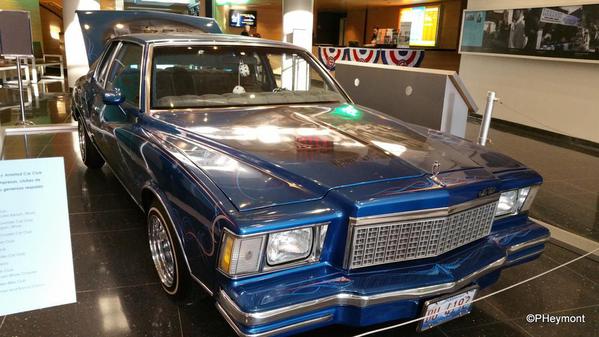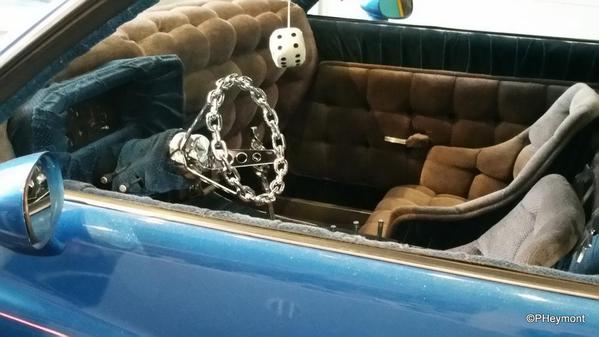When it comes to the great Chicago Fire of 1871, seen in a diorama above, the Chicago History Museum knows all about it: The museum, founded in 1856, was destroyed in the fire and had to start again from scratch—only to burn again in 1874. You'll not be surprised to know that the museum's third home was built as fireproof as they come.
That building is still standing, but since 1932 the Museum has occupied bigger quarters facing Lincoln Park, and has had a couple of additions since to hold its large and varied collections, which include the wall of neighborhood signs and scenes above (and a facing display of more on the opposite wall. The lobby really sets the tone for a museum that is as nearly complete and as nearly quirky as can be. The tone is further set by the first exhibit you see in the lobby: a customized lo-rider.
Elsewhere, what I guess could be called a hi-rider...
The day we visited, a Wednesday afternoon, the museum was full of families and classes, and many of the museum's areas are designed for groups like that, asking questions as well as presenting information. Facing Freedom, just below, was one of those; it's filled with exhibits of Chicago-area history such as the struggle of the Pullman workers, campaigns for school integration, and connections to more. The signs and text ask viewers how they might have reacted in each of the situations, and how the outcome affects their lives today.
We moved on to The Secret Lives of Objects, a clever way the Museum has found to both illustrate many facets of Chicago's history, and also to display some of the eccentric accumulations of its doting donors, some of whom seem to have been as much packrat as patron. Each object is accompanied by text in which it "speaks" of its silent but important role in life and history. The many pieces on display are as disparate as a paing-bucket that did duty as a drum during a Chicago teacher strike, a newsboy's wagon, the table on which Lee's surrender was signed in 1865 and an index card documenting the Chicago police 'red squad' surveillance of writer Studs Terkel.
This one is a fire-damaged hymnal recovered years later from the burned-out ruins of one of the churches that went up in the Great Fire of 1871. Below it, a more recent relic; some of you who are old enough may remember as I do when the phone booth was for use, not display.
One of the first cars to run on the El, Chicago's elevated railway system, serves as an information and display booth.
Sports fans get an area to celebrate Chicago's long, if not always glorious, sports history. The Cubs are the nation's oldest professional sports franchise (1866), but they haven't won a World Series since 1908, as reflected in the headline on this display. The items below are from Chicago's entry in one of the women's professional baseball leagues of the 1940s-50s, but from a rival of the league featured in A League of Their Own.
Chicago's two World's Fairs, 1893 and 1933, each had a major influence on the city's growth, and on architecture and planning. The first, a big comeback from the fire, showed off Chicago's growth, and Daniel Burnham's 'White City' design for the fair buildings set a 30-year influence on public buildings across the country. In the exhibit on the 1933 fair, the narrative notes a continuing Chicago theme: conflict over issues of race and class, haves and have-nots.
In the same era, railroad operators used campaigns like these to build off-peak traffic to the Lake Michigan beaches; summer traffic to the beaches also helped fuel suburban development along the rail lines.
The Museum handles many of the issues of conflict in Chicago's history with a relatively even hand, presenting both sides and the issues; in some cases it seemed to me that 'fair' was not always 'accurate.' Some samples below from the 1886 Haymarket incident, campaigns for integration of housing and schools in the 1950s and 60s, and the 1968 Democratic Convention in Chicago.
The museum also pays homage to Chicago's central role as an industrial city, highlighting such industries as iron and steel, manufacturing of all kinds (including the recent Weber Kettle!) and especially its role, in Carl Sandburg's words, as "Hog Butcher to the World."
As if to prove the point of what Chicago's stockyards could do with animals besides meat and glue: this steer-antler chair is made entirely with stockyard products.
Chicago industry has some other claims to fame, including a role in producing the atomic bomb and nuclear energy (the first controlled chain reaction took place under the University of Chicago's football stadium) and the invention of an industry that thrives today, although not for its founders. The first mail-order catalogs came from Chicago companies Sears and Montgomery Ward.
All this industry depends on transportation for its goods, and to this day Chicago is criss-crossed with innumerable rail lines. Through the end of January, the Museum is featuring an incredible exhibit of Jack Delano's World War II-era photographs of Chicago-area railroad workers, their families and their jobs.
Chicago at the turn of the last century was the home of such architectural giants as Burnham, Sullivan and Adler, and Frank Lloyd Wright. They left a mark on Chicago; many of their iconic buildings remain in use. One that isn't, the old Stock Exchange, is represented at the museum by its trading floor, re-assembled in the museum as an event space. Here's part of the architecture exhibit.
The architectural boom brought with it a demand for furniture and decorative objects to fill the spaces, and the Museum has a sampling of them as well. My favorite is the glorious lunette window by George W. Mahler.
Another exhibit highlights the work of Chicago-area reformers in a number of areas, including John Dewey in education, Jane Addams, whose Hull House was one of the first big settlement houses, and Upton Sinclair, whose campaign for justice for packing-house workers in his novel The Jungle led instead to the first meat inspection laws.
And Chicago's long history as a theater center, continuing to today with many companies, including Steppenwolf, and of course the improv company that bears the ironic name by which many of us know Chicago: The Second City. In reality, it's in many ways second to none.
We can't leave Chicago without a word for another of its famous industries: the underworld. Legendarily home to more gangsters per square mile than anywhere else (possibly not true), it was especially the home of the most famous: Al Capone. The final irony of the day: it's awfully hard to argue with Capone's comment in the picture below!





Comments (0)